It is mid-June, and many backcountry ski enthusiasts have turned their energy to their favorite dirt and water outdoor pursuits. But while the sun may be blazing here in North America, the snow is just starting to fly south of the Equator, and for a lucky few, a trip to the Southern Hemisphere keeps the snow train chugging along.
To begin our summer series “Austral Aspirations,” we talked with SheJumps Executive Director Claire Smallwood, who has been making the trip to South America since 2010. Running a nonprofit can be an exhausting endeavor, but to provide some perspective and renew her love of adventure, Smallwood travels south every year to take some austral winter ski time for herself.
This is her sixth year traveling to Chile, and so we caught up with Smallwood before her journey to find out why she loves the Andes and what keeps her going back.
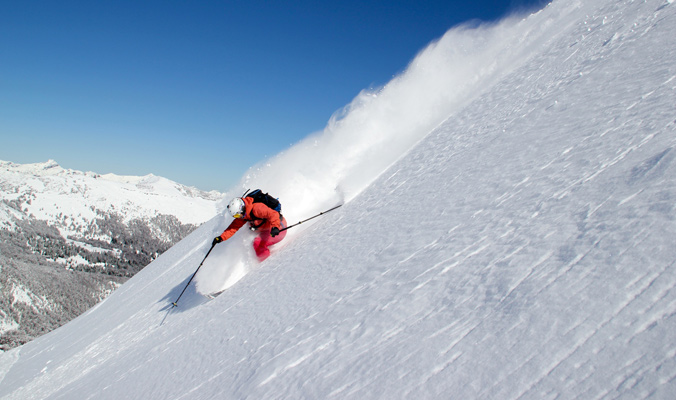
Claire Smallwood cuts through the light powder of Chillan, Chile. [Photo] Spencer Francey
Backcountry Magazine: Why did you start going down to South America during the summer?
Claire Smallwood: The reason I started going down there was initially because I wanted to be able to experience having winter in the middle of summer. The idea was really foreign to me, and I had never skied in another country besides the U.S., so I was drawn to that sense of travel and adventure. But I have a background in languages, so I wanted to go somewhere based on wanting a combination of a cultural experience and skiing.
BCM: What is a memorable experience you have had down there?
CS: The first winter I went down there was one of the worst winters they have had in the last 10 years. On top of that, on the third day into the trip my ski bag flew off of the top of the bus that I was on and got run over by a semi truck. All of my ski stuff got ruined except for my ski boots. So, the fact that I have continued to go down to South America speaks to how much I really love it. When that happened I was initially totally devastated, but luckily, there are a handful of gringos that head down there now, so I was able to get a pair of skis from my buddy Chad. The only extra skis he had were 192cm Black Diamond Zealots. So I skied those for three weeks. I think that initial experience really motivated me to go back and experience better snow, but I also wanted to ski with my own skis. And I knew that I had already gone through the most extreme bout of travel in Chile, so I though, “Well, I survived that, so I might as well go back.” Now I know not to let anyone else put my skis on top of busses except for myself, because if I do it, I have no one else to blame if they fly off the top.
![Claire has learned to take her luggage inside the taxi. [Photo]](http://backcountrymagazine.com/wp-content/uploads/2016/06/claire_embed_6.jpg)
Claire has learned to take her luggage inside the taxi. [Photo] Spencer Francey
BCM: What is the draw to summer skiing?
CS: I never had a summer sport. I love to hike, and I mountain biked when I was growing up and just recently got back into it, but in 2010 when I decided to go down there, I hadn’t had another sport that really called to me during the summer.
BCM: How do you feel that traveling to South America every summer informs your work with SheJumps?
CS: It is a reset for me. I think there is this misconception that the Executive Director of SheJumps is super rad and extreme when the reality of running a nonprofit is really not that extreme and adventurous. So being able to go there really resets my sense of adventure and the feeling and sentiment that SheJumps wants to promote within people. I really like that it is my opportunity to go and experience that.
It is my time to selfishly have for my own. It is my own adventure instead of me trying to create adventures for others through SheJumps programming, which I spend the rest of my time doing. This is my personal program.
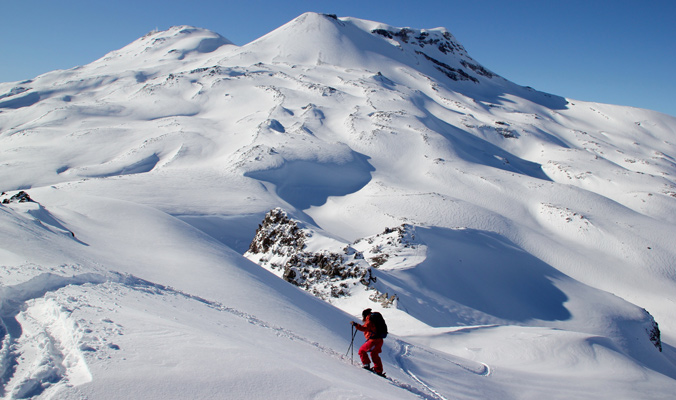
Volcanoes grace the landscape of Chile. [Photo] Spencer Francey
CS: People often ask me what the snow is like down there, and I think that is a really loaded question. If you want to book a vacation to Utah next winter you are going to roll the dice regardless. You don’t know what’s good snow and what’s not good snow. So it reestablishes a sense of “Buy the ticket, take the ride.” And I just go into it with an open sense of just going to have fun. As we say, there is always the “C Factor,” and in Argentina it’s the “A Factor,” because you might think that something is going to happen a certain way or at a certain time and it just doesn’t. You have to let go of that Type A, “I’m on a vacation, and I have to get x,y and z accomplished and if I don’t I have failed” mentality. You have to let go and let the adventure take you and realize that even if you have down days and can’t ski, there are still plenty of other things to keep you occupied. You can always learn and practice Spanish and take in all of the cultural aspects of the trip.
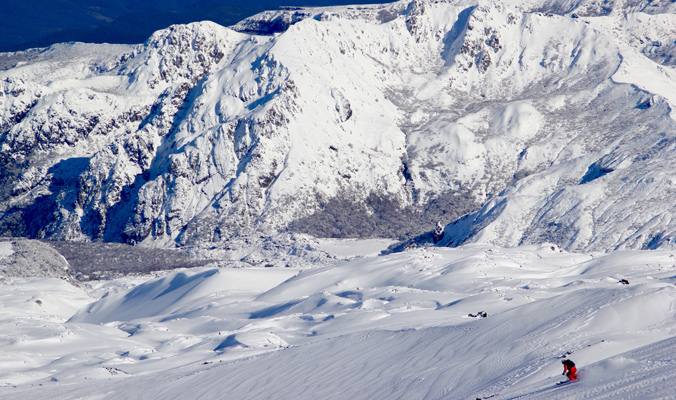
The Andes loom above as Claire makes her way to the valley floor. [Photo] Spencer Francey
CS: First and foremost, how you feel physically is different, because almost all of the towns are heated with woodstoves, so when you drive into the villages and it’s cold, there is the smell of smoke in the air. So your senses are immediately taken to this feeling of sitting by the fire. The other funny thing culturally with Chileans is that even if it’s not cold outside, they dress for the season. So it might be a warmer day but because it is winter, people might be wearing scarves and hats.
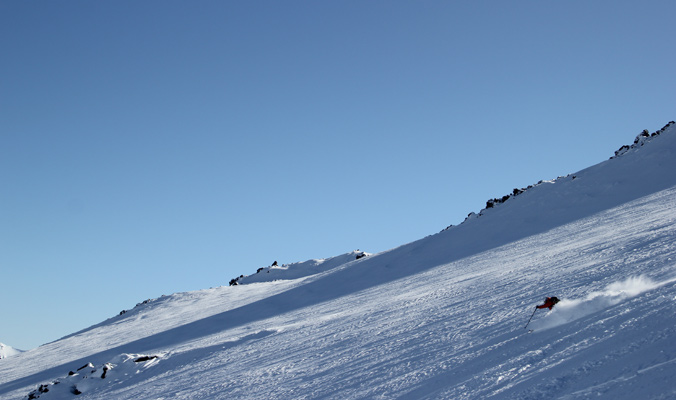
A spec amidst the white. [Photo] Spencer Francey
CS: Before I go down there, I try to get as many projects tabled as I can. What has evolved in the last six years is that the internet is much better down there. It used to be that you would walk for a couple miles in a village to find a place with working Wifi. Luckily, with that evolving, SheJumps has evolved. Six years ago, SheJumps wasn’t at the level that it is now, so I could get away with not working as much as I am now. Back then my job was 100 percent volunteer. Now I can go skiing during the day, but I might have to come back and open up my computer and crank out a couple hours of work.
Our tag line for SheJumps is, “What great things would you dare to accomplish.” I want to show that you can have a day job, an office job and live that life if you can find the balance. SheJumps encourages this ethos in people and I want to see that in myself.
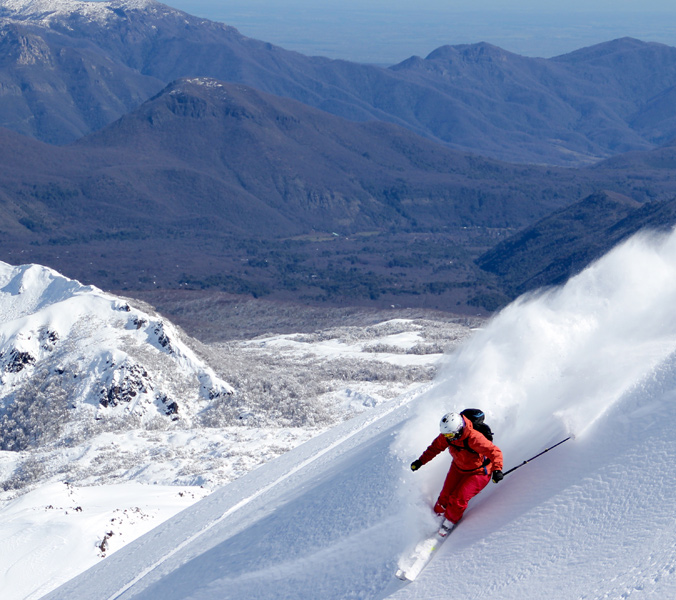
Mountains rise quickly in Chile, the snowline visible lower in the valley. [Photo] Spencer Francey








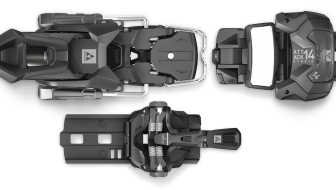

Related posts:
Summer Stashes: Grizzly Peak, Colorado
Summer Stashes: Gallatin Peak
Summer Stashes: Mount Adams
Summer Stashes: ST. MARY'S GLACIER